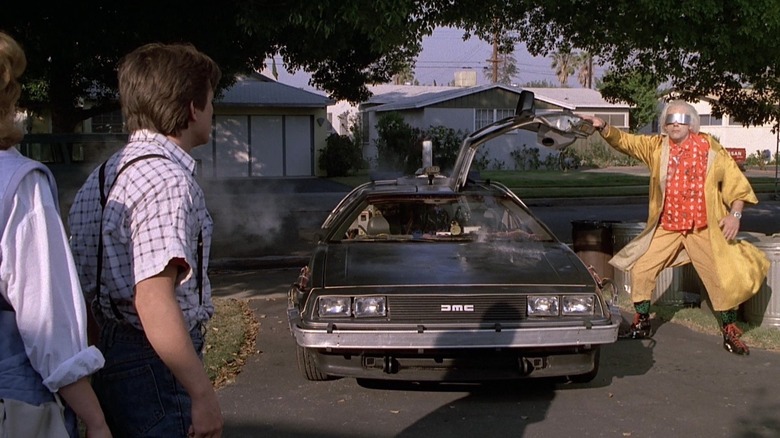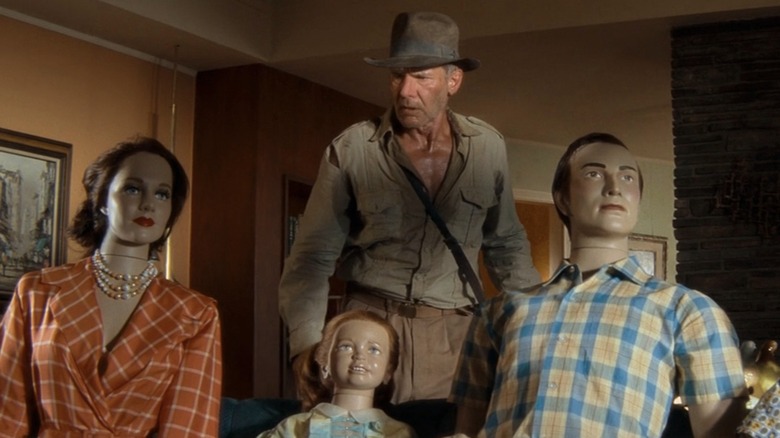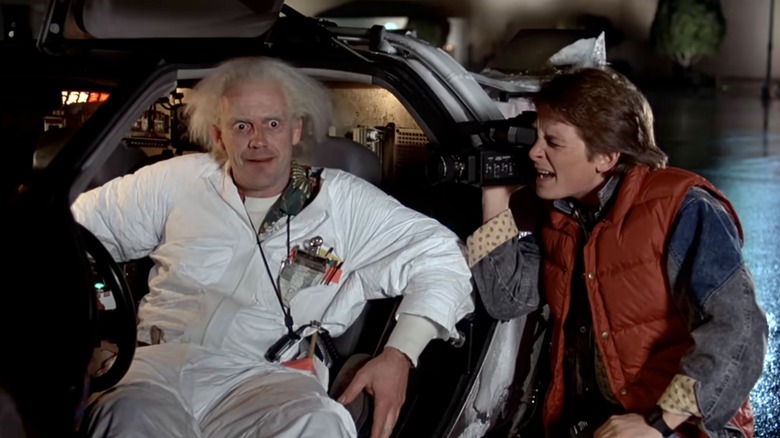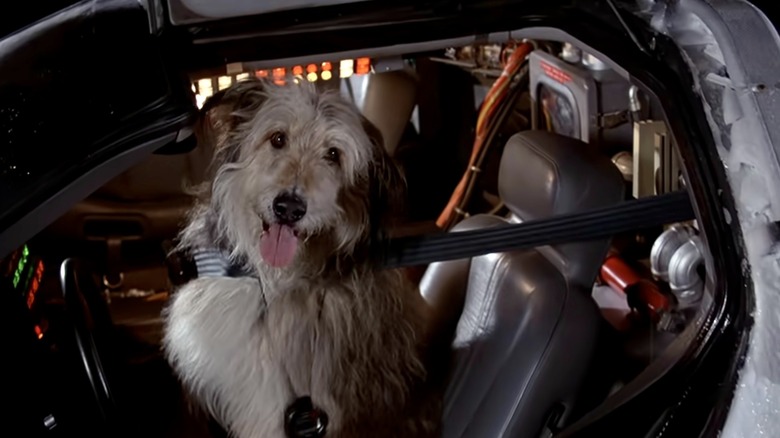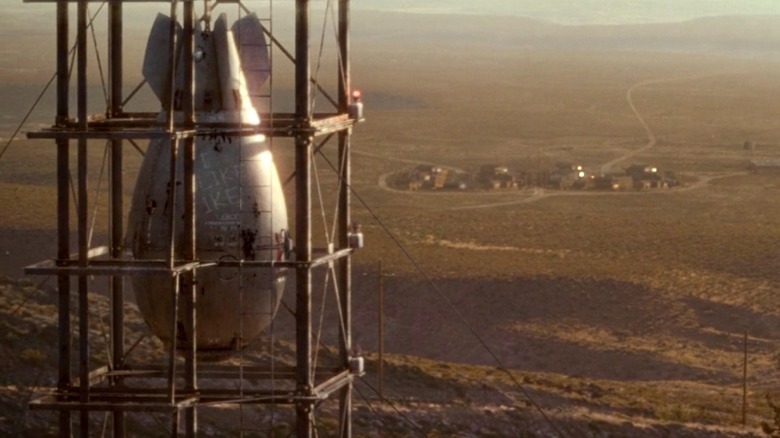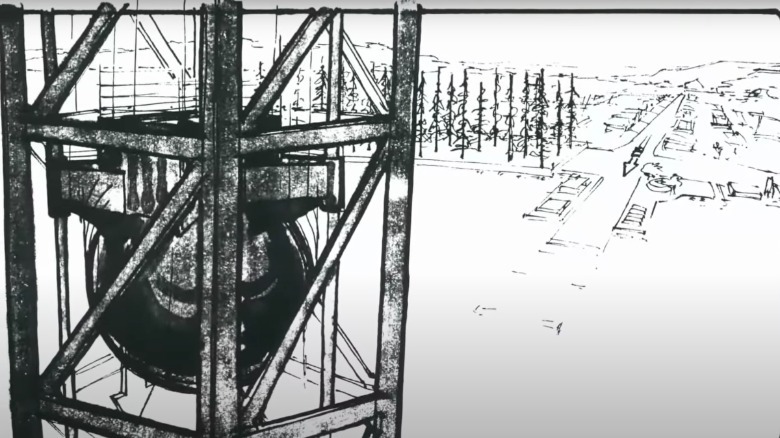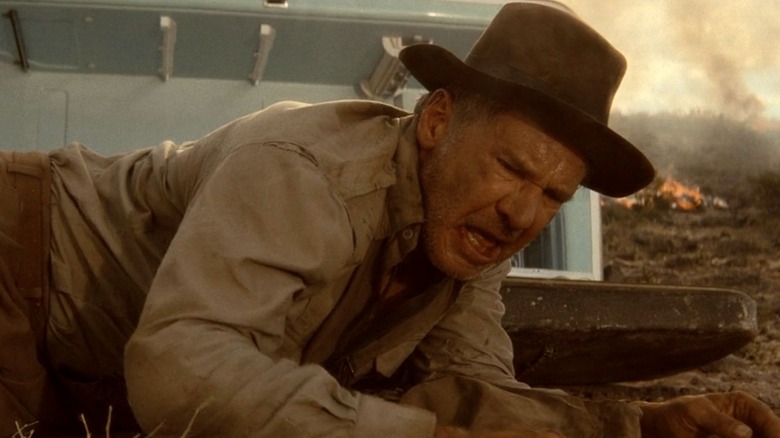Back To The Future's Original Time Machine Wasn't Nearly As Stylish As The DeLorean
What do "Back to the Future" and "Indiana Jones and the Kingdom of the Crystal Skull" have in common? They both involved Steven Spielberg and nuking the fridge. In the case of "Back to the Future," however, the time-traveling fridge was written out of the script before it ever made it to the screen. In its place, screenwriters Bob Gale and Robert Zemeckis (the latter of whom directed the film, with Spielberg executive producing through Amblin) inserted the well-known DeLorean as their time machine.
The DeLorean was only manufactured from January 1981 to December 1982, but the image of the car with its gull-wing doors has become synonymous with "Back to the Future." It's a big moment when Doc Brown (Christopher Lloyd) backs the DeLorean out of a truck into the parking lot of the Twin Pines Mall for the first time. As he climbs out of the driver's seat, we see that he's wearing a radiation suit, and he soon reveals to his young assistant, Marty McFly (Michael J. Fox), the reason for that. It's because the DeLorean requires a nuclear reaction to generate the electricity it needs. It runs on plutonium, which Doc has stolen from a Libyan nationalist group.
It's not long before this same group drives in and guns Doc down, leaving Marty to escape on his own in the DeLorean. When he hits 88 miles per hour, he accidentally activates the time machine, sending him back to 1955, two years before the bomb blast that Indiana Jones (Harrison Ford) survives in "Kingdom of the Crystal Skull." Forget riding the lightning; it seems the third act of "Back to the Future" would have originally put Marty in a lead-lined fridge instead of the DeLorean and had him riding out a nuclear explosion the way Indy does.
Marty McFly and the Kingdom of the Crystal Skull
This summer, "The Flash" joked about an alternate reality where Eric Stoltz played Marty McFly (based on the real production history of "Back to the Future," in which Stoltz shot scenes for the film before Michael J. Fox replaced him). But many other young actors auditioned for the role, including "Two and a Half Men" star Jon Cryer. In 2020, before the release of a new 35th-anniversary "Back to the Future" box set with footage from his audition, Cryer took to Twitter to reveal details of an early draft of the script he read:
"The final sequence didn't involve a clock tower or a lightning bolt, but instead finds Marty sneaking onto a [sic] atom bomb test site with his time machine to be near the nuclear fission that he needs for it to work. In an eerie scene he finds ... The test site is complete with exquisitely detailed suburban houses and mannequins to simulate the effects of an atomic explosion on an American town."
The Indiana Jones franchise saved its time machine for "Dial of Destiny," where the Archimedes Dial acts as a MacGuffin that NASA-inspired Nazi scientist Jürgen Voller (Mads Mikkelsen) hopes to use to turn back time on the Second World War's outcome. However, after its opening sequence — where Indy and a group of KGB agents spend time wandering around the "Raiders of the Lost Ark" warehouse-like lost children — "Kingdom of the Crystal Skull" puts Indy on a rocket sled and launches him into his own version of the model town scene. A TV in one house plays "The Howdy Doody Show," which is quoted right at the beginning of the first draft of Robert Zemeckis and Bob Gale's "Back to the Future" script (via ScreenCrush).
Coke-fueled time travel
"Back to the Future" is no stranger to product placement, with a JCPenney sign, for instance, hanging over Marty McFly's shoulder in the mall parking lot. However, it almost went one step further and made Coca-Cola the secret ingredient for Doc Brown's time-traveling fridge. According to Live Science, most sodas are almost as corrosive to the teeth as battery acid, so maybe it's not a stretch to think that funneling Coke into a power converter could be just the thing to get a time machine working.
That's what happens in the original "Back to the Future" script, where Marty, like Indiana Jones, finds himself in a house populated by mannequins, where the TV is playing "The Howdy Doody Show." It's a nuclear test site, but the fridge is stocked with Coke. As Jon Cryer explains, Marty "climbs in, closes the door behind him, the bomb goes off, the time machine activates, and he's simultaneously shot #BackToTheFuture."
Things play out differently for Indiana Jones, as anyone who's seen "Kingdom of the Crystal Skull" can attest. Yet as Cryer notes, "clearly [Steven] Spielberg loved the scene and repurposed it decades later." Though many have sought to blame Indy creator George Lucas for it, it seems Spielberg wasn't lying when he took responsibility for nuking the fridge.
We've seen other instances in Hollywood of a producer shepherding a questionable idea from movie to movie. One example is filmmaker Kevin Smith's famous story about how Warner Bros. commissioned him to write a Superman film, with producer Jon Peters dictating that the hero had to fight a giant spider in the third act. The movie never got made (though its Nicolas Cage version of Superman did cameo in "The Flash"), so Peters used the giant spider idea for "Wild Wild West" instead.
We named the dog Einstein
The first draft of the "Back to the Future" script is dated February 1981, while "Kingdom of the Crystal Skull" hit theaters in May 2008. This means the nuking the fridge idea survived at least 27 years of development.
While David Koepp is the sole credited screenwriter for "Kingdom of the Crystal Skull," you can see how the nuking the fridge concept predated him in earlier drafts of the script, such as the version "The Shawshank Redemption" director Frank Darabont wrote (back when the movie was called "Indiana Jones and the City of the Gods"). That version is dated November 2003, but sure enough, Howdy Doody and nuking the fridge are there, proving themselves as resilient as cockroaches in the nuclear apocalypse.
There's even a shot in "Kingdom of the Crystal Skull" that looks like it was ripped straight from Andrew Probert's storyboards for the "nuclear test site sequence" in "Back to the Future." The camera pulls back to show the bomb tower looming over the test site, and it's virtually identical to one storyboard, as you can see below.
In "Back to the Future," Marty McFly says to Doc Brown, "Are you telling me that you built a time machine out of a DeLorean?" He's incredulous at the idea, but Doc reasons, "If you're gonna build a time machine into a car, why not do it with some style?"
For Doc, "style" includes not only a personalized license plate ("OUTATIME"), but also a dog named Einstein. (Cue Sean Connery saying, "We named the dog Indiana.") The dog sits in the driver's seat as the test subject for Doc's first "temporal experiment," not unlike how George Lucas used to drive around with his Alaskan Malamute seated up front before the dog-inspired Chewbacca.
Nuking the fridge to success
After he loads plutonium into the DeLorean, Doc Brown stresses that it's safe because "everything's lead-lined," like a good airtight screenplay. One can only imagine how incredulous the audience might have been if Doc had funneled Coke into his time machine, and if "Back to the Future" had put Marty McFly in a fridge and nuked it instead of having the clock tower struck by lightning.
Then again, this was before everyone was online to pick movies apart, so maybe viewers in 1985 would have been more forgiving. Either way, "nuking the fridge" has gotten a bad rap, insofar as the phrase now indicates the point at which a movie series begins to decline (similar to "Happy Days" "jumping the shark" on TV.)
The real kiss of death for "Indiana Jones and the Kingdom of the Crystal Skull" is not its fridge-nuking set piece, which actually has some momentum to it, but rather, the quieter inertia that sets in after Indy leaves the U.S. Steven Spielberg himself didn't do that when he was making the movie; he wanted to remain stateside with his family, and it shows in the movie's CGI-reliant, soundstage look.
The film grinds to a halt when it sets down for 12 minutes of screen time in a Russian camp. Indy spends seven minutes sitting in the same interrogation chair, and no sooner does he escape than he's rendered immobile by quicksand again. It's like everyone suddenly forgot that a motion picture is supposed to have motion in it.
That's not a problem that "Back to the Future" suffers from as Marty McFly puts the pedal to the metal in his time-traveling DeLorean. Maybe in another life, though, Eric Stoltz is out there, riding the success wave of a fridge gone nuclear.
